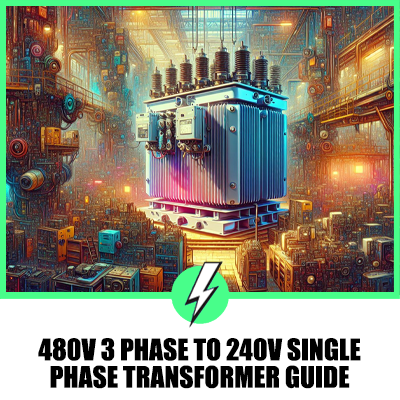480v 3 Phase to 240v Single Phase Transformer Guide
Need to convert 480v 3 phase power to 240v single phase for your equipment?
It sounds specialized, but it’s a common requirement across various industries. If this is your current challenge, rest assured, it’s a manageable one with the right tools—specifically, a 480v 3 phase to 240v single phase transformer.
This piece of equipment is a game-changer, allowing you to bridge the gap between different electrical systems safely and efficiently.
Well, we’ll be going over:
- Why is understanding your electrical system’s basics crucial before attempting any conversions?
- What are the primary functions and benefits of using a 480v 3 phase to 240v single phase transformer in your operations?
- How can this transformer not only ensure the smooth running of your equipment but also contribute to operational efficiency and safety?
Let’s dive in

Contents
Understanding Electrical Systems
When you’re delving into electrical systems, it’s crucial to know the basics. Electrical systems are categorized by their voltage and phase.
This distinction is important because it determines how power is transmitted and what equipment can be operated.
For example, 480v 3 phase systems are commonplace in industrial settings, but 240v single phase systems are more often found in residential or light commercial environments.
Transitioning between these systems requires specific equipment, like a 480v 3 phase to 240v single phase transformer.
This transformer does more than just convert power; it ensures that your equipment can run efficiently and safely in environments not originally designed for them.
So, why is this important? Understanding the nuances of electrical systems enables you to make informed decisions.
Whether it’s for selecting the right equipment for your operations or ensuring the safety of your work environment, knowledge is power.
By now, you should be beginning to appreciate the role that such transformers play in bridging the gap between diverse electrical systems.
Importance of Converting 480v 3 Phase to 240v Single Phase
Understanding the crucial role of transforming 480v 3 phase to 240v single phase isn’t just about technical compliance; it’s about unlocking operational efficiency and safety in your projects.
If you’re managing or involved in industrial settings, you’re likely to encounter machinery that runs on 240v single phase, despite the prevalent 480v 3 phase power supply. This disparity isn’t a mere inconvenience.
It’s a challenge that, when addressed properly, can significantly enhance the performance and safety of your equipment.
At the heart of this conversion is the 480v 3 phase to 240v single phase transformer, a device that not only adapts power to the required level but also ensures that the electricity running through your systems is stable and safe.
This stabilization is critical, particularly in environments where fluctuations in power can result in equipment damage, downtime, or even safety hazards.
By investing in the right transformer, you’re not just complying with operational standards; you’re ensuring that your operations run smoothly and safely, leveraging the full potential of your equipment without the risk of power inconsistencies.
Functionality of a 480v 3 Phase to 240v Single Phase Transformer
Understanding the functionality of a 480v 3 phase to 240v single phase transformer is key to appreciating its role in your industrial setup.
Essentially, this type of transformer allows you to convert the high voltage 480v power, which is commonly used in industrial environments, down to a more manageable 240v single phase power.
This conversion is crucial for a wide range of machinery and equipment that operates more efficiently on lower voltage or requires a single-phase power supply.
The process involves a few critical steps. Initially, the transformer receives the 480v 3 phase power input. Through its internal windings, this power is then step down and converted into 240v.
The choice of transformer design, be it delta or wye configuration, plays a significant role in how effectively this conversion is handled.
What stands out in this conversion process is the transformer’s ability not just to lower the voltage but to do so in a way that ensures the output is stable and consistent.
This stability is paramount for preventing equipment malfunction or damage, thereby guaranteeing smoother operations and enhanced safety on the work floor.
By integrating one of these transformers into your system, you’re taking a step towards optimizing your operations for both performance and safety.
Applications and Industries Utilising the Transformer
When you consider upgrading or installing electrical systems in industrial settings, understanding the widespread applications of a 480v 3 phase to 240v single phase transformer is crucial.
These transformers play a pivotal role across various sectors, ensuring the machinery operates efficiently and safely.
In the manufacturing industry, these transformers are indispensable. They provide the required voltage for heavy-duty machines that demand precise power levels to manufacture products.
From automotive assembly lines to food processing plants, the reliability of a 480v to 240v transformer cannot be overstated.
Construction sites also benefit immensely. Portable power tools and temporary lighting often require 240v single phase power. Utilising transformers ensures consistent power supply, reducing downtime and boosting productivity.
Similarly, in the agricultural sector, where irrigation systems and farm equipment rely on stable and efficient power, these transformers bridge the gap between the available high voltage supply and the machinery’s requirements.
This ensures that operations run smoothly, enhancing overall production yield.
By integrating a 480v 3 phase to 240v single phase transformer into your operations, you’re not just ensuring equipment safety; you’re optimising performance across tasks and industries.
Benefits of Using a 480v 3 Phase to 240v Single Phase Transformer
When you opt for a 480v 3 phase to 240v single phase transformer, you’re investing in versatility and efficiency for your industrial operations.
One of the key advantages is the reduction in electrical loads. By distributing power more evenly, these transformers decrease the chances of overloading circuits, ensuring a safer work environment.
Additionally, these transformers are crucial for downscaling. They allow high-voltage equipment to connect seamlessly with lower-voltage devices, ensuring that you can use a wide range of machinery without the need for multiple power sources.
This not only saves space but also significantly cuts down on energy costs.
Moreover, the implementation of a 480v to 240v transformer enhances power quality.
With stable and reliable power supply, your equipment runs more efficiently, with less wear and tear over time. This means lower maintenance costs and fewer interruptions in your operations.
Conclusion
Opting for a 480v 3 phase to 240v single phase transformer is a smart move for your industrial needs. It’s not just about ensuring your machinery runs smoothly and safely.
You’re also looking at significant savings on energy costs, space efficiency, and a notable reduction in electrical loads.
This choice directly contributes to enhancing your equipment’s performance and extending its lifespan, which means less downtime and lower maintenance costs.
With all these benefits, it’s clear that such a transformer is an essential investment for boosting productivity and safety in your operations. Embrace this technology to stay ahead in the competitive industrial landscape.





